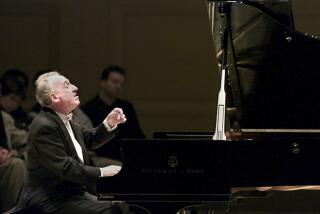MUSIC REVIEW : Penneys and Burge at USC
- Share via
Given the range of 20th-Century piano literature, it would still be difficult to come up with a more fascinating minisurvey than the brief one offered by Rebecca Penneys and David Burge, who played at the Arnold Schoenberg Institute, USC, on Thursday night.
Seven works for solo piano--by Rodolfo and Ernesto Halffter, Leon Kirchner, Robert Morris and Peter Lieberson--made up the body of this program.
They were capped by a sizable piece for piano, four hands, by George Crumb, his “Celestial Mechanics” (1979). Throughout, the two pianists, both members of the faculty at the Eastman School of Music in Rochester, N.Y., gave strong accounts of music they obviously believe in.
Crumb’s “Mechanics” stretches the resources of the instrument, not beyond anything invented by John Cage in the 1940s, but in the same directions.
He uses the surfaces of the piano--especially inside surfaces--by plucking, scraping, strumming and knocking them in expressive ways. The subtitle of this work, “Cosmic Dances,” promises as much as Crumb delivers; the entirety seems otherworldly and extraterrestrial. With an assistant, whose duties included page-turning, Penneys and Burge made the 22-minute piece convincing.
Less persuasive, through a lack of perceived continuity, was Burge’s authoritative performance of Robert Morris’ formulaic “Exchanges” for piano and tape (1983; 1989), a work receiving its second performance in a revised version.
The problem is the composer’s: Every part of the piece resembles every other part through its absence of direction or movement; the static quality of the writing makes the whole (15 minutes) seem endless.
In neo-Scarlatti sonatas and ballet music by the Brothers Halffter, Penneys produced as charming a sound and characterful performances as the hard-edged instrument at the institute will allow.
Penneys also made strong cases for Kirchner’s hardy Sonata (1948) and Lieberson’s cherishable Bagatelles (1985).
More to Read
The biggest entertainment stories
Get our big stories about Hollywood, film, television, music, arts, culture and more right in your inbox as soon as they publish.
You may occasionally receive promotional content from the Los Angeles Times.










